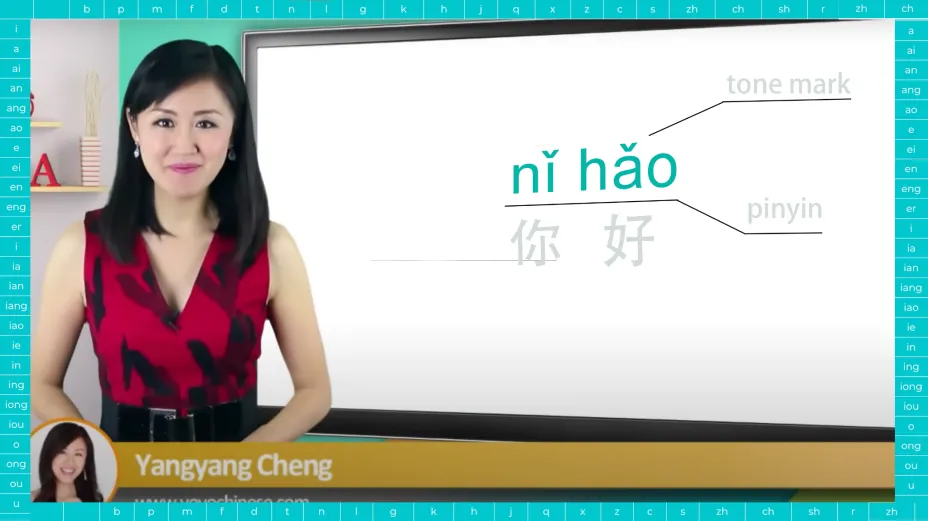
What is the Chinese Alphabet?
Chinese utilizes a logographic writing system instead of an alphabet, with characters that stand for ideas and concepts rather than sounds. Chinese speakers do, however, also employ a system known as pinyin (拼音 pīn yīn), which is quite close to a Chinese alphabet.

What is Pinyin?
Pinyin is a system that uses the Latin alphabet to represent the sounds of Mandarin Chinese. It was created in the 1950s and has since grown into a crucial tool for teaching Chinese as well as for inputting Chinese characters on computers and mobile devices. People typically find it simpler to learn how to pronounce Chinese words with the help of pinyin rather than starting with Chinese characters alone. Even though it is not a Chinese alphabet in the traditional sense, Pinyin represents the sounds of the Chinese language using the well-known letters of the Latin alphabet.
We created an Interactive Pinyin Chart to aid Chinese language learners in mastering pinyin and pronunciation. By practicing with our audio examples and visual explanations for each potential sound combination in the language, you can learn how to speak Chinese with native-like pronunciation.

Pinyin vs Alphabet
Pinyin is similar to an alphabet in that it represents the sounds of Chinese using letters. However, there are some key differences between the two systems. Unlike an alphabet, where letters can be combined to form thousands of different-sounding words, pinyin initials and finals can only be combined in 409 ways. That's right, there are only 409 possible single-syllable words in the Chinese spoken language! Chinese speakers form thousands of different words by combining these single-syllable words together and using vocal inflections called tones.
Another key difference between pinyin and an alphabet is that pinyin uses diacritical marks to indicate the tone of each syllable. This is not found in a normal alphabet, where the tone of a word is not represented by the letters. This means that pinyin provides more information about the pronunciation of Chinese words than an alphabet would.
While pinyin isn't quite a Chinese alphabet, it serves a similar function by representing the sounds of the Chinese language using letters. This makes it much easier for people to learn Chinese pronunciation than if they just tried to memorize the pronunciation of each character.
What are Chinese Characters?
Chinese uses a logographic writing system rather than an alphabet, where each character stands for a concept or idea. Most characters are composed of multiple smaller components that indicate the character's meaning or sound. Here is a little video tutorial on Chinese characters:
A Brief History of Written Chinese
Chinese writing has been used for more than 4,000 years. It is thought to have started when people began using inscriptions on objects like bronze and bone to keep track of events and communicate with the gods. Chinese characters evolved over time, becoming increasingly standardized and utilized for a range of things like official documents, literature, and everyday communication. It is one of the oldest writing systems still in use today, and is used by millions of people around the world.
Over the years, written Chinese has seen many modifications. Early in the 20th century, the Chinese government instituted a number of reforms meant to make learning Chinese characters simpler. These reforms included advocating the use of pinyin as a method to represent Chinese sounds and simplifying some of the more complicated Chinese characters. The Chinese language is still developing and adapting to modern technology and communication requirements.
Want to really start
learning Chinese?
Try Yoyo Chinese for free!
Advantages of Chinese Characters Over a Chinese Alphabet
The Chinese spoken language has many homophones, which are words that have the same pronunciation but different meanings. For example, there's a poem written by Yuen Ren Chao (赵元任 Zhào Yuánrèn) titled “Lion-Eating Poet in the Stone Den” -《施氏食狮史》. Using the Chinese logographic writing system, it looks like this:
石室诗士施氏,嗜狮,誓食十狮。
氏时时适市视狮。
十时,适十狮适市。
是时,适施氏适市。
氏视是十狮,恃矢势,使是十狮逝世。
氏拾是十狮尸,适石室。
石室湿,氏使侍拭石室。
石室拭,氏始试食是十狮。
食时,始识是十狮尸,实十石狮尸。
试释是事。
The characters represent ideas and concept, allowing a reader to understand this poem without issue. But using the phonetic writing system of pinyin, the closest thing to a Chinese alphabet, it looks like this:
shí shì shī shì shī shì, shì shī, shì shí shí shī.
shì shí shí shì shì shì shī.
shí shí, shì shí shī shì shì.
shì shí, shì shī shì shì shì.
shì shì shì shí shī, shì shǐ shì, shǐ shì shí shī shì shì.
shì shí shì shí shī shī, shì shí shì.
shí shì shī, shì shǐ shì shì shí shì.
shí shì shì, shì shǐ shì shí shì shí shī.
shí shí, shǐ shí shì shí shī shī, shí shí shí shī shī.
shì shì shì shì.
Even with the tone marks, the homophony of these words makes the poem incomprehensible when written in pinyin.
Using a phonetic Chinese alphabet to write Chinese would result in a lot of ambiguity, since it would be difficult to tell which word was intended based on the pronunciation alone. The logographic writing system allows for greater precision and clarity in written communication since Chinese characters represent the concepts themselves.
Frequently Asked Questions
-
Is there a Chinese alphabet?
No, there is no Chinese alphabet. Unlike languages that use an alphabet, where each letter represents a sound, Chinese uses a logographic writing system of characters, which represent ideas and concepts.
-
Is pinyin the Chinese alphabet?
Pinyin is a system that uses the Latin alphabet to represent the sounds of Chinese. It was created in the 1950s and has since grown into a crucial tool for inputting Chinese characters on computers and mobile devices as well as for teaching Chinese. Chinese language learning is made simpler by pinyin. Although pinyin is not an alphabet in the classic sense, it does a comparable task by employing well-known Latin letters to represent Chinese sounds.
-
How many letters are there in the Mandarin Chinese alphabet?
The written language of Mandarin Chinese does not use a phonetic alphabet, it uses logographic characters. But for children and non-native speakers that want to learn Chinese characters, there is a system similar to a Chinese alphabet called pinyin. Pinyin has 21 initials and 38 finals, with a total accepted combinations of 409 (see our Interactive Pinyin Chart> for reference).
-
What is the official alphabet, or ABC, in China?
Mandarin Chinese, unlike many other languages, does not have a phonetic alphabet. Instead, it uses logographic characters. However, for those who are want to learn Chinese characters, such as children or non-native speakers, there is a system called pinyin that functions like a Chinese alphabet and can help with pronunciation.
-
How does the Chinese writing system compare to an alphabet?
Written Chinese and an alphabet are fundamentally different ways of representing language. An alphabet is a system of writing in which each letter represents a single sound. This allows words to be represented by a series of letters, each of which represents a single sound used to pronounce the word. In contrast, written Chinese is based on characters, which represent ideas and concepts rather than sounds.
-
What Chinese characters should I learn first?
Learning just 300 Chinese characters will enable you to understand 64% of any given Chinese text! Here's a YouTube video where we explain this and introduce our Chinese Characters Course, the best way to learn Chinese characters online!
-
How do I type Chinese on my English keyboard?
You can actually type Chinese characters with your English keyboard using pinyin! Here's our article with step-by-step instructions for how to do just that: How to Type in Chinese on Any Device.
-
How is the Chinese language written and structured?
汉字 (hàn zì, Hanzi) is a system of characters that is used to write Chinese. 汉字 (hàn zì, Hanzi) are logographic characters that convey thoughts or concepts rather than specific sounds. The number of hanzi characters is in the tens of thousands.
Radicals, the basic parts that make up hanzi characters, are the foundation of the written Chinese language. Radicals can offer hints to a characters pronunciation or meaning and can also be used for the categorization of characters in dictionaries and typing tools.
-
How did written Chinese originate and how has it evolved over time?
The Chinese writing system has a long and complex history that spans more than 4,000 years. The earliest known examples of written Chinese consist of inscriptions on oracle bones and bronze artifacts. These early writings were often used for divination or as records of important events.
Over time, written Chinese evolved and became more sophisticated. During the Western Han Dynasty (202 BCE-9 CE), written Chinese underwent significant standardization, and a set of 214 radicals was established to organize and classify characters. This system remains the basis of modern written Chinese.
In the centuries that followed, written Chinese continued to evolve and adapt to changing social and cultural needs. In the 1950s, the Chinese government introduced a set of simplified characters as a way to make the language easier to read and write. Today, simplified characters are used in mainland China, Singapore, and Malaysia, while traditional characters are used in Taiwan, Hong Kong, and Macau.
-
How do Chinese characters differ from other writing systems?
There are several ways that Chinese characters are different from other writing systems. Chinese characters are logographic, but the majority of other writing systems are phonetic, which is one of the key contrasts. This means that rather than representing a particular sound, each Chinese character symbolizes a thought or idea. Different sounds are represented by a set of characters or letters in most other writing systems, such as the English alphabet, and these sounds are combined to make words.
The amount of characters employed in the writing system is another significant distinction. Written Chinese, in contrast to other alphabetic writing systems, has tens of thousands of individual characters, and students must commit a significant number of these to memory in order to read.
Chinese characters are also more complicated and have a different visual layout than other writing systems. Chinese characters are made up of a variety of strokes and patterns, making it challenging to learn how to write them correctly. In contrast, the majority of alphabetic writing systems use relatively straightforward, recognizable characters.
-
What resources can help learners of the Chinese language?
We're so glad you asked! We've worked very hard over the last 10 years to make Yoyo Chinese the best way to learn Chinese online! We have 6 courses with over 1,000 video lessons, quizzes and practice activities written by Chinese language learning experts to make your learning journey successful and enjoyable!Click here to try it for free!
-
How do Chinese characters work with electronic devices?
On electronic devices like computers, smartphones, and tablets, Chinese characters can be typed using a variety of input techniques and software applications. On electronic devices, there are a few different ways to type Chinese characters, including:
-
Pinyin input: By utilizing the QWERTY keyboard to enter the character's Romanized pronunciation, users of this technique can type Chinese characters. The pinyin input will then be converted by the computer or device into the appropriate Chinese characters. Here's our article about How to Type in Chinese on Any Device using pinyin input.
-
Handwriting input: Using a pen or their finger on a touch screen, users can draw Chinese characters on some electronic devices that support handwriting input. The handwritten characters will subsequently be recognized by the device and turned into typed text.
-
Keyboard input: Chinese characters can also be typed using specialized keyboards that are available. These keyboards can help with effectively typing Chinese characters because they frequently have extra keys or characters that are not present on a conventional QWERTY keyboard.
An electronic device needs have a Chinese font installed and the correct language and character set selected in order to show Chinese characters. The system will then be able to appropriately display Chinese characters.
Overall, there are a number of tools and techniques available to make the process simpler and more effective, even if inputting Chinese characters on electronic devices can be slightly more difficult than typing an alphabetic language.
-